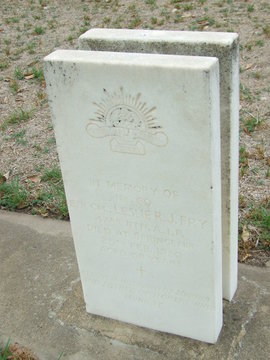FRY, Leslie Robert James
| Service Number: | 60 |
|---|---|
| Enlisted: | 11 January 1916, at Adelaide |
| Last Rank: | Second Corporal |
| Last Unit: | 43rd Infantry Battalion |
| Born: | Athelstone, South Australia, August 1890 |
| Home Town: | Goodwood, Unley, South Australia |
| Schooling: | Not yet discovered |
| Occupation: | Labourer |
| Died: | Springbank, South Australia, 25 February 1950, cause of death not yet discovered |
| Cemetery: |
West Terrace Cemetery (AIF Section) Section: KO, Road: 13, Site No: 29 |
| Memorials: |
World War 1 Service
| 11 Jan 1916: | Enlisted AIF WW1, Private, 60, 43rd Infantry Battalion, at Adelaide | |
|---|---|---|
| 9 Jun 1916: | Involvement Private, 60, 43rd Infantry Battalion, --- :embarkation_roll: roll_number: '18' embarkation_place: Adelaide embarkation_ship: HMAT Afric embarkation_ship_number: A19 public_note: '' | |
| 9 Jun 1916: | Embarked Private, 60, 43rd Infantry Battalion, HMAT Afric, Adelaide | |
| 31 Jul 1917: | Wounded AIF WW1, Private, 60, 43rd Infantry Battalion, Warneton, GSW leg | |
| 24 Mar 1918: | Wounded AIF WW1, Private, 60, 43rd Infantry Battalion, German Spring Offensive 1918, GSW buttocks | |
| 18 Apr 1920: | Discharged AIF WW1, Second Corporal, 60, 43rd Infantry Battalion |
Help us honour Leslie Robert James Fry's service by contributing information, stories, and images so that they can be preserved for future generations.
Add my storyBiography contributed by St Ignatius' College
Before the war
Leslie Robert James Fry was born in 1890 in Athelstone, Adelaide in Australia and was the son of Robert Fry. His spouse was Martha Agnes Woolige. His religion was Methodist. Leslie was amongst the many Australians that were Methodists at the time.
Enlisting for war
Leslie enlisted for the war on the 11th of January 1916 at the age of 24. He wasn’t married and shipped off to war on the 9th of June 1916 on the HMAT A19 Afric. It is not certain what reasons Arthur enlisted for war but a common reason for registering was peer pressure by friends and family to prove that you had the strength to fight for your country. Another motive could have been that more than two-thirds of Australians were from a British background at that point in time and they felt obliged to help a country that had established their own. The war was also showcased in a positive light and many men had the ‘war fever' and were anticipating the chance for an adventure.
During the war
Fry was enlisted as part of the 43rd Battalion.
A war diary from July 1917 states that the 43rd Battalion travelled around many towns in France. The 43rd Battalion spent 1917 bogged in bloody trench warfare in Flanders. In June the battalion took part in the battle of Messines and in October the Third Battle of Ypres. The battalion spent much of 1918 fighting in the Somme valley. In April they helped stop the German Spring offensive at Villers-Bretonneux.
Leslie was wounded on 31 July 1917 at the battle of Warneton. He was wounded in the leg. After recovering in England he returned to duty in January 1918. He was wounded again on 24 March 1918, this time in the buttocks. On this occasion he returned to duty in August 1918. Leslie was unwell many times and was sick with influenza. He travelled back and forth to hospitals between September and December in 1917. 1 Australian Auxiliary Hospital, Harefield Park, Greater London and 2 Command Depot, Weymouth, Dorset Royal Herbert Hospital, Woolwich, Greater London. Throughout his time at war, Fry won two medals: the British War Medal and the Victory Medal.
Leslie Robert James Fry was fortunate enough to return back home on the 29th of the 12th 1919.









